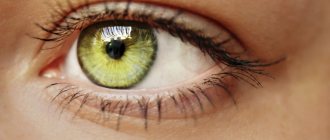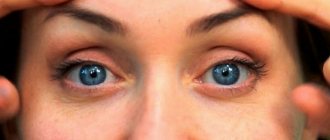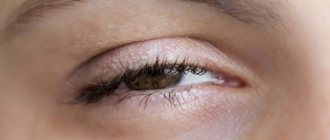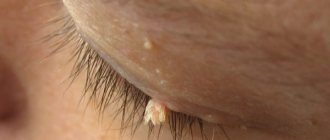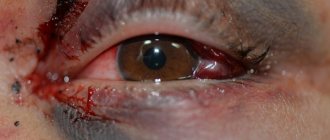Redness of the mucous membrane of the eyes and the skin around them can be due to various reasons: from the influence of external irritants to ophthalmological diseases (conjunctivitis, corneal ulcer, glaucoma).
This manifestation can be dealt with with the help of medications and folk remedies. We’ll talk about how to quickly remove redness from the eyes below.
Possible causes of redness
Redness in or around the eyes is not a specific symptom and does not indicate the presence of a specific disease.
Redness of the mucous membrane of the eyes
This phenomenon may be due to the following factors:
- influence of external factors. Acceleration of blood flow in the capillaries of the organs of vision and their rupture can be caused by direct ultraviolet rays, low temperatures, strong winds, cigarette smoke, city smog, foreign objects (dust, litter, animal hair, city smog);
- injury or burn to the organs of vision. Irritation and disruption of the integrity of eye tissue can be associated not only with mechanical factors (impact, but also with the irritating effect of aggressive chemicals. They can be included in soaps, shampoos, and cleaning products. Chlorinated water also causes irritation;
- physiological reactions of the body. Blood vessels in the area of the visual organs can burst and cause redness due to severe tension in the eye muscles, high blood pressure, and exposure to allergens;
- deficiency of vitamins and microelements in the body. Redness of the eyes often occurs in response to a lack of vitamins A, B1 and B2, C, which take part in the restoration processes of the tissues of the organs of vision and protect them from negative external influences;
- alcohol consumption. Alcoholic drinks cause dilation of blood vessels in internal organs, skin and eyes;
- smoking. Tobacco smoke irritates the mucous membrane of the organs of vision. In addition to redness, this bad habit can provoke the development of dangerous abnormalities - macular degeneration, cataracts due to the presence of hazardous substances in tobacco smoke;
- the presence of diseases of internal organs and systems. Redness of the eyes occurs with hypertension, low blood clotting, spondyloarthritis, arthritis, diabetes;
- diseases of the visual organs (glaucoma, dry eye syndrome, keratitis, conjunctivitis, corneal ulcer);
- wearing lenses. Redness of the eyes occurs at the beginning of their use as a reaction to a foreign body. If for a long time the eyes are not accustomed to vision correctors and the redness does not go away, then this indicates that they were incorrectly selected;
- incorrectly selected glasses;
- the use of low-quality cosmetics (eye shadow, mascara) or their incomplete removal;
- pregnancy, childbirth. When the fetus is formed, changes in blood volume occur in the body. Due to overcrowding, blood vessels in the eyes may burst and redness may occur. During childbirth, hemorrhages in the eyes occur due to pushing;
- working at a computer or reading in low light conditions.
Causes of redness under the eyes
Redness under the eyes is associated with the following reasons:
- pathologies of the urinary tract and kidneys (inflammation, urolithiasis);
- allergic reactions;
- pathologies of the skin (dermatitis, seborrhea);
- metabolic disorders in the body (deviations in the thyroid gland, diabetes);
- lack of vitamins and minerals;
- stress, lack of sleep;
- disturbances in intestinal function;
- inflammation with a focus of development under the skin, localized next to the organ of vision (phlegmon, abscess).
To determine the exact cause, you need to see a doctor and undergo a series of diagnostic tests.
Causes
Redness on the face may be a consequence of exposure to external negative factors. If there is no such manifestation, the cause should be sought in internal malfunctions of the body. The doctor should identify the primary factor to prevent the condition from reoccurring.
External
The following external causes can affect a person, causing redness of the skin around the eyes:
- the use of cosmetics to which a person may have an individual intolerance; they may be expired or of poor quality;
- stress, nervous overstrain, during which a large number of hormones are released into the blood, affecting the redness of the skin surfaces;
- allergic manifestations to animal fur, bird feathers, seasonal flowering of plants, house dust, chemicals;
- individual intolerance to the drug or inadequate intake of a drug that was not prescribed by a doctor;
- scratching the skin around the eyes with nails or other mechanical damage.
In this case, redness of the skin around the eyes is eliminated when the factor that caused it is completely eliminated. The patient will also need additional drug therapy to eliminate the redness.
Domestic
There are various diseases that can cause the skin around the eyes to turn red:
- pathologies of the liver tissue, when spider veins appear under the skin, mainly on the face;
- proliferation of a pathogenic fungus due to inadequate antibiotic therapy or immunodeficiency in the patient;
- the spread of pathogenic bacteria on the skin around the eyes, this can be staphylococcus, streptococcus, chlamydia, gonococcus and other pathogens;
- the effect of a viral agent on the entire body, which traveled through the blood to the eyes and caused inflammation of the conjunctiva, cornea and eyelids (herpes, adenovirus);
- pathologies of the adrenal glands, thyroid gland and other endocrine disorders;
- metabolic disorders, such as diabetes;
- dermatological pathologies (dermatitis, seborrhea, rosacea);
- inflammatory conditions of the eyelids (blepharitis) due to the influence of various negative factors (chalazion, meibomitis, purulent infection, irritation);
- increased blood pressure, which can occur only once or develop chronically (hypertension).
Any of the above pathologies requires systemic treatment with medications and the addition of traditional therapy. All appointments must be carried out only under the supervision of a physician.
Methods to quickly eliminate red eyes
You can cope with redness of the mucous membrane of the organs of vision with the help of medicines and traditional methods.
Medicines
If the cause of rupture of blood vessels in the tissues of the eyes is dryness, overexertion or ophthalmic diseases, then you can use eye drops.
Depending on the purpose, such drugs narrow dilated blood vessels, fight redness, reduce tearing, reduce swelling and capillary permeability, and promote the resorption of intraocular hemorrhages.
Before using drops to combat red eyes, you need to determine the cause of this phenomenon and only then begin treatment.
Traditional methods
Traditional medicine offers many options that help cope with redness of the organs of vision.
Such methods are available and help quickly. Special cold compresses and solutions of medicinal herbs are used as remedies.
Selection of drops for eye redness according to the principle of action
The specialist selects ophthalmic drops against eye redness based on what problem needs to be solved. The following groups of topical drugs are used:
- vasoconstrictors. The agents affect the receptors of the walls of blood vessels and, thanks to the active components, localize redness, swelling and itching. The most effective drugs in this group are Vizin, Alomide, Octilia. They are recommended for diseases of the vascular system, allergies, active stress on the eyes, and some ophthalmological pathologies;
- antibacterial. Such drops are necessary for inflammatory processes that spread to the visual system. They are prescribed for keratitis, barley, conjunctivitis, blepharitis, which also causes redness of the eyes. The group of antibacterial ophthalmic drops includes Albucid, Tsiprolet, Levomycetin, Tobrex. Drops fight pathogens that provoke the development of the disease and suppress symptoms;
- vitamin complexes. Drops of this type are recommended for those whose work involves a computer and whose eyes are under increased strain and get tired. Also, drops with vitamins are necessary for vitamin deficiencies to replenish vitamins and microelements and in the treatment of certain eye diseases (glaucoma, corneal dystrophy, myopia, cataracts). When using ophthalmic drops with vitamins, the lens and cornea are quickly nourished. Pain, irritation and redness disappear. Popular vitamin complexes in ophthalmology are drops Taufon, Quinax, Vitafacol, Riboflavin, Sencatalin;
- anti-allergy drops. Local antihistamines relieve the symptoms of an allergic reaction. Such agents as Cromohexal, Opatonol, Allergodil are in demand;
- means for faster adaptation of the eyes to the lenses. Such ophthalmic preparations prevent dryness, pain, irritation of the mucous membrane, and combat redness and eye fatigue. Systane Balance, Visiomax, Reticulin drops have these properties;
- moisturizing drops. They are used for eye diseases and conditions that are accompanied by increased dryness of the mucous membrane. In their composition, such products are as close as possible to natural tear fluid. The group of moisturizing drops includes Natural Tear, Defislez, Inoksa, Vizmed, Stillavit;
- preparations for restoring the structure of eye tissue after surgery. Solutions not only relieve inflammation and redness, but also prevent the possibility of infection. In this case, the drugs Oftan, Maxidex, Dexamethasone are suitable.
Each drug in the form of drops against redness of the eyes has contraindications and a list of possible adverse reactions, so before using them you need to consult a doctor and carefully study the instructions.
Why does irritation occur?
Most often, patients suffer from allergic reactions and harmful environmental influences. This is not surprising, because many today live in cities with a lot of transport, factories and hazardous industries. All this negatively affects the health and condition of the visual organs. Allergies can be caused by low-quality cosmetics, dust, pollen, animal hair, food, household chemicals and much more.
Often, irritation around the eyes appears for completely natural reasons. The fact is that the epidermis in this area is highly prone to peeling. Therefore, if a person has spent some time in the cold or, conversely, in extreme heat, unpleasant symptoms may appear. As a rule, it disappears after a few days and with the use of moisturizers. However, this condition should not be confused with dermatitis. If the skin under the eyes feels tight for a long time and there is a burning sensation, then this may be a more serious illness.
Another cause of irritation around the eyes can be rosacea. This condition represents dilated capillaries in this area. If the patient suffers from this, then his eyes will be very itchy. There will be a feeling that there is a foreign body under the skin. If the pathology continues to progress, then the redness can spread to other areas not only of the face, but also of the whole body.
There are situations when irritation around the eyes is caused by conjunctivitis. In this case, irritation of the mucous membrane of the visual organ occurs. The main symptoms of this disease are: severe itching, pain in the eyes and the appearance of high sensitivity to bright light.
Sometimes unpleasant symptoms are associated with blepharitis. With this disease, the eyelash edge becomes inflamed. As a rule, people over 40 years of age suffer from this pathology. However, in recent years, cases of similar manifestations in children have begun to be recorded. The inflammatory process is the result of the activity of bacteria, fungi and viruses. When staphylococci multiply rapidly, irritation appears around the eyes, and if treatment is not started, a strong burning sensation will appear and the skin will begin to peel off.
Ways to combat red eyes without ophthalmic drops
If you need to eliminate redness of the eyes quickly, but you don’t have the necessary ophthalmic agent at hand, you can use folk remedies. The most effective of them:
- compress with vegetables, apple and fresh egg. You need to take a medium cucumber, peel it and grate it on a fine grater, squeeze out the juice - it won’t be useful. Do the same with potatoes and apples. Combine all the resulting slurry, add lightly beaten egg white, mix well. Apply to red eyes and leave for 20 minutes, then rinse thoroughly;
- drops with honey. Take a tablespoon of boiled chilled water, add a drop of natural honey, mix thoroughly until completely dissolved. Immediately drop 2 drops of the resulting product into the affected eye;
- contrasting chamomile compresses. Take a teaspoon of dry crushed chamomile and pour 100 ml of boiling water. Leave for 10 minutes, then strain and divide into 2 parts. Heat the first half to a comfortable temperature, and, on the contrary, cool the second half. Take 2 gauze napkins, soak them in warm broth, and leave for 10 minutes. Then dip in cold broth and leave again for 10 minutes;
- infusion of cornflower flowers for washing the eyes. Take a tablespoon of dried flowers, pour 250 ml of hot water and let it brew for an hour. Strain and rinse reddened eyes with infusion;
- potato compress. If the redness is accompanied by severe pain in the eyes, you can use this simple remedy. Wash large potatoes without peeling them and cut them into 2 parts. Apply the cut side to the eyes and leave for 30 minutes.
You should not use those components included in folk remedies that can provoke an allergic reaction and aggravate irritation.
How to quickly remove redness under the eyes?
You can quickly deal with red circles under the eyes using the following methods:
- tea compresses. You need to brew the tea firmly and wait until it cools to a comfortable temperature. Dip cotton pads into the tea leaves and apply to areas of redness under the eyes. Leave for 10-20 minutes;
- compress under the eyes with fresh parsley. Finely chop a bunch of washed parsley. Place the greens in gauze bags and apply to problem areas. Leave for 20 minutes;
- ice cubes. Freeze water in special cells (you can also freeze chamomile decoction). Wrap the resulting ice cubes in gauze and lubricate the reddened areas under and around the eyes.
Sometimes, to eliminate redness around the eyes, it is enough to use a soothing cream with a moisturizing effect. It's better to do this before bed.
General recommendations
If the redness of the eyes is not caused by pathological reasons, then you can cope with them without special medications. You need to pay attention to the following recommendations:
- observe hygiene standards. When using decorative cosmetics before going to bed, it should be washed off thoroughly so that the particles do not irritate the mucous membrane. When wearing contact lenses, it is important to regularly rinse them in a special solution. It is unacceptable to touch your eyes with your hands, especially if they have not been thoroughly washed;
- Protect your eyes from direct exposure to ultraviolet rays. You need to use sunglasses with a high-quality coating that reliably protects the tissues of the visual organs from external factors;
- monitor your diet, be sure to include in your menu foods with vitamins that are good for vision (raw carrots, black currants, parsley);
- organize the correct rest regime. The eyes should rest 7-8 hours a day. While working at the computer or reading, you need to give your visual organs a short rest - at least 5-10 minutes per hour;
- do eye exercises and massage. It is useful to blink quickly (about 40-50 times), make circular movements with your eyes clockwise and counterclockwise, look alternately into the distance and at a point nearby.
If signs of ophthalmic diseases appear, you should immediately consult a doctor.
Possible inflammation
Of course, the most common cause of skin redness is allergies. But a reaction to allergenic substances and conjunctivitis, which causes inflammation, are not all the reasons why the skin peels. In addition to conjunctivitis, there are other causes. Rashes and rashes around the eyes can also indicate more serious illnesses. It is possible that it is blepharitis. With blepharitis, swelling is accompanied by itching. The eyelids peel and become covered with a rash if a person gets demodex. It is possible that the redness of the skin near the eye is caused by stye.
Redness of the area around the eyes can also be caused by internal factors. It is possible that irritation around the eyes indicates the following diseases of the whole body:
- about kidney diseases;
- about a lack of vitamins;
- about allergies.
Redness of the skin near the eyes can also be an indicator of mental illness and nervous diseases caused by constant insomnia and fatigue.
Attention! If the disease is ophthalmological in nature, then you can use the products only as prescribed by a doctor.
It is possible that this is a cold or stye after exposure to the cold, or, even worse, a consequence of an insect bite. Swelling on the eyelids may indicate stye. Organ dysfunctions are less common, but can also cause redness of the eyes and skin. The skin around the eyes is particularly susceptible to various diseases.
Special cases of red eyes and the fight against this symptom
- How to deal with red eyes after eyelash extensions?
Redness and dryness of the eyes after extensions may indicate an allergic reaction caused by the materials used, a chemical burn, or microtrauma to the eye mucosa.
If symptoms do not go away within three hours after the extension procedure, it is recommended to consult a doctor.
You can cope with redness yourself by using antihistamine eye drops. If inflammation occurs due to infection, antibacterial drops will be needed.
To relieve unpleasant symptoms, you can use cool compresses with decoctions of medicinal herbs: sage, thyme, chamomile.
- How to deal with redness after crying?
In this case, cucumber will help. You need to take 2 thin slices of the vegetable, cool (you can put it in the refrigerator) and apply it to your eyes. Leave for 10-15 minutes.
- How to remove redness after drinking alcohol?
You can cope with eye inflammation after drinking by using vasoconstrictor ophthalmic drops. Sofradex and Visin are suitable.
Other ways are to gently massage the eye area with your fingertips, drink more pure water and green tea without sugar, and apply a cloth soaked in ice water to your eyes.
- How to deal with redness if a vessel in the eye bursts?
For hemorrhages, it is permissible to use Emoxipin and Taufon. If the phenomenon is associated with increased blood pressure, you need to consult a doctor to prescribe special medications (for example, Enap, Cardilopin).
- What to do if your eyes are red in case of conjunctivitis?
In this case, antibacterial drops and ointments prescribed by your doctor will help.
Treatment
Treatment for the disease depends on the cause that caused it. The following remedies can be used to eliminate inflammation:
- antihistamines for oral administration (Suprastin, Cetrin, Erius);
- antihistamine drops for topical use, if the inflammatory reaction is also concentrated on the eyeballs (Allergodil);
- antihistamine ointments based on dexamethasone or other steroids;
- non-steroidal anti-inflammatory drugs based on diclofenac;
- antibacterial ointments (Levomekol, Erythromycin or Tetracycline ointment);
- antiviral ointments (Florenal, Tebrofen, Bonafton);
- systemic antiviral drugs (Acyclovir, Ingavirin);
- complex ointments based on antihistamines and antibacterial agents (Eubetal, Dex-Gentamicin);
- rubbing the inflamed skin with decoctions based on herbal ingredients if the condition is not caused by an allergic reaction or the patient does not have hypersensitivity to the active ingredient (chamomile, string, coltsfoot, calendula);
- antifungal drugs (Nystatin);
- complex treatment of a systemic disease, for example, if redness is caused by diabetes, insulin dosage adjustment is required.
After treatment, it is recommended to take repeated tests and undergo instrumental examination by a doctor. This is necessary to prevent relapse.



